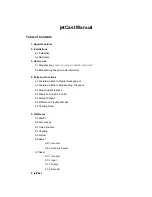
30
Chapter 3 Introduction to J2EE
J2EE environment
The J2EE platform represents a single standard for implementing and deploying
multitier enterprise applications. Typically, such applications are configured as a
client
tier
to provide the user interface, one or more
middle tiers
that provide client services
and business logic for an application, and a
data tier
consisting of backend enterprise
information systems (EIS) that provide data management.
The following figure shows the tiers and some of the components and services that make
up a typical J2EE environment:
Distributed applications consist of distinct components running in separate runtime
environments, usually on different platforms connected through a network. Typical
distributed applications are two-tier (client-server), three-tier (client-middleware-server),
and multitier (client-multiple middleware-multiple servers).
The tiers have the following characteristics:
•
Client tier
Supports a variety of client types, both outside and inside of corporate
firewalls. Clients can run on desktops, laptops, PDAs, cell phones, and other devices.
Client-side user interfaces can use HTML and Java applets. J2EE also supports
stand-alone Java application clients.
•
Middle tier
Supports client services through web containers (includes Java Servlets
and JSPs) and business logic components and services through the EJB container.
The middle tier resides on the J2EE server.
•
Data tier
Supports access to existing information systems through standard APIs.
The data tier includes enterprise infra-structure systems, such as enterprise resource
planning (ERP), mainframe transaction processing, database systems, and other
legacy information systems.
Summary of Contents for 38000382 - Macromedia JRun - Mac
Page 1: ...Getting Started with JRun...
Page 16: ......
Page 68: ...54 Chapter 5 Introduction to EJB...
Page 82: ......
Page 110: ...96 Lesson 3 EJB Tutorial...
Page 128: ...114 Lesson 4 Web Services Tutorial...
Page 132: ...118 Index...
















































